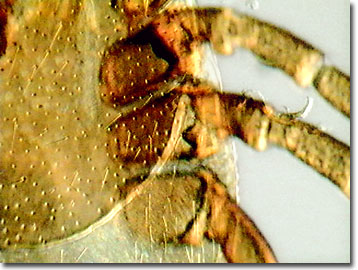Oblique Digital Image Gallery
Deer Tick (Ioxedes scapularis)
The deer or black-legged tick, Ioxedes scapularis, is a small parasitic arachnid about the size of a sesame seed or freckle, and has made the news for about the last decade as the carrier of the dreaded Lyme disease. Named for Lyme, Connecticut, where the tick-borne illness was first identified, Lyme disease is caused by a species of bacterium that is carried by deer ticks among infected white-tailed deer, domestic animals, and humans.

The non-human hosts appear to be carriers or bacterial reservoirs and are not apparently plagued by the Lyme disease symptoms. With an increasingly mobile population and deer populations that are approaching nuisance levels in some metropolitan areas, the deer tick and its companion, the Lyme disease spirochete (Borrelia burgdorferi), have spread rapidly across North America. According to the Centers for Disease Control, more than 16,000 Lyme disease infections are reported annually.
Deer ticks await suitable mammalian hosts in grassy areas and in woodlands with their outstretched legs. When a host is located, the deer tick grabs on to the hair or skin and uses its barbed mouthparts to sink in and secure a grip. Much smaller than the common American dog tick or cattle ticks, deer ticks are no bigger than pinheads in their larval and nymph stages, making them extremely hard to detect and remove. Nymphal Ioxedes ticks are most likely to transmit infection after feasting on human blood for two or more days.
Lyme disease may at first seem like a mild or severe case of the flu, but often evolves into debilitating chronic arthritis and sleep disorders. A characteristic bulls-eye rash is accompanied by fever, fatigue, muscle aches, and headache. Control and management is possible by mowing the high grasses and brushy habitat favorable to ticks, and by holding down mammal populations (deer and mice). Prevention using chemical repellants and protective clothing is helpful and treatment in the early stages with antibiotics is quite successful. For some, avoiding the outdoors during the warmer months, particularly in areas where vegetation may contact the skin, seems like the best solution. A vaccine has been developed, but is no longer commercially available.
Contributing Authors
Cynthia D. Kelly, Thomas J. Fellers and Michael W. Davidson - National High Magnetic Field Laboratory, 1800 East Paul Dirac Dr., The Florida State University, Tallahassee, Florida, 32310.
BACK TO THE OBLIQUE IMAGE GALLERY
BACK TO THE DIGITAL IMAGE GALLERIES
Questions or comments? Send us an email.
© 1995-2025 by Michael W. Davidson and The Florida State University. All Rights Reserved. No images, graphics, software, scripts, or applets may be reproduced or used in any manner without permission from the copyright holders. Use of this website means you agree to all of the Legal Terms and Conditions set forth by the owners.
This website is maintained by our
Graphics & Web Programming Team
in collaboration with Optical Microscopy at the
National High Magnetic Field Laboratory.
Last Modification Friday, Nov 13, 2015 at 01:19 PM
Access Count Since September 17, 2002: 12534
Visit the website of our partner in introductory microscopy education:
|
|
